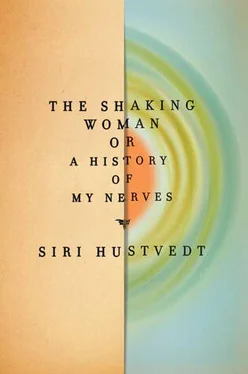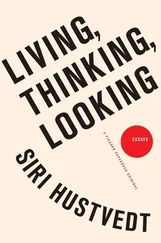Right-hemispheric damage often results in the syndromes I have mentioned before: denial of illness, anosognosia or what neurologists call anosodiaphoria, the admission of illness but without concern: Janet’s la belle indifférence, which we saw in Todd Feinberg’s patient Lizzy, who didn’t seem to give a jot about her blindness, even when she admitted to it, and neglect. It is weird but true that if you pour cold water into the left ear of a neglect patient, the anosognosia will disappear. A patient of V. S. Ramachandran’s did not acknowledge that she was paralyzed on the left side and that her left arm was effectively useless. Mrs. M. insisted that she was fine, could walk, could use both her hands, and when forced to look at the dead left hand claimed that it belonged to her son. 84After her doctor poured ice water into her ear, she freely admitted her paralysis and acknowledged that her body had been that way ever since her stroke. Ramachandran confessed that witnessing the phenomenon made him take Freud’s idea of repression seriously for the first time. It was obvious that at an unconscious level Mrs. M. knew she was paralyzed, but on a conscious level she did not want to know.
Karen Kaplan-Solms and Mark Solms cite Ramachandran’s experiment in their book Clinical Studies in Neuropsychoanalysis . In one chapter, they describe five patients with right hemisphere damage. Each patient was treated neurologically but was also given psychotherapy. Although their lesions were not unalike (they all had right perisylvian damage), each person had a unique response to his or her injuries. Nevertheless, they all showed various forms of repressing or denying the bad news that they were no longer the same as they had been before. Their responses contrast sharply to Zazetsky’s, who had left hemisphere damage and was, from the beginning, acutely and painfully aware of what he had lost. He repressed nothing. Neil, too, understood that he was forgetful and knew well that after his tumor and the radiation to shrink it, he had changed. It is easy to conclude that right-sided injuries create a fundamental inability in these people to know what has gone wrong with them. But the authors disagree: “These patients are indeed continuously encoding information about their defective bodies, and at some deeper level they do indeed have knowledge about their handicaps and the emotional implications thereof. All that they lack is the capacity — or as we are suggesting — the inclination to attend to this knowledge, to permit it into conscious awareness.” Or, to repeat Janet’s words: In reality what has disappeared… is the faculty that enables the subject to say clearly, “It is I who feel, it is I who hear. ” It is I who am ill. It is I who remembers.
One of these patients, Mr. D., had suffered a cerebral hemorrhage but had made an impressive recovery. He had mild deficits on his left side, most of which were concentrated in an unwieldy left hand that was also subject to involuntary twitching. The authors point out that although Mr. D. had for a time denied his illness and neglected his left side after the bleeding in his brain, these symptoms had subsided. In its place, he developed a virulent hatred for his own left hand: “I’ll smash this hand into a million pieces and post the pieces to the surgeon, in envelopes, one by one.” The authors comment, “At one point, Mr. D. actually stated that the hand felt as if it did not belong to him. The hand thus represented some part of his own self that he had both lost and disowned . An analysis of his attitudes in this regard suggested that, in fact, he was trying to turn the passive experience of losing it into an active experience of disowning it.” 85Rather than neglect the bad hand, not admit that it was there or that it belonged to him, he wanted to expel it from his “I,” to refuse to accept that it was part of him.
Some of the other patients Kaplan-Solms and Solms studied displayed both denial of illness and la belle indifférence, but during sessions their analyst noticed that her patients’ blasé attitudes faltered. Mrs. B., who declared that she had come to terms with the handicaps that remained after her stroke, was subject to severe crying jags, which she insisted she didn’t understand, but when the catalysts were examined — an article about a thalidomide child born without limbs, for example — it was plain that she had been reminded of what she had lost. Her indifference masked what she understood in another part of herself and served as a shield against unbearable feelings. Another woman, who had neglect, anosognosia, and multiple visual and spatial difficulties, Mrs. A., explained her severe depression by saying that she kept “losing things,” things like her glasses and cigarettes. But with her analyst she associated these minor losses to much greater ones: the loss of her uterus in a hysterectomy when she was still a young woman and the loss of her father when she was only a girl. She is quoted as saying, “I was never able to mourn the loss of my father.” 86One loss becomes linked to another and then another. There are too many. It is much easier to fret over missing glasses and cigarettes. Solms and Kaplan-Solms use their cases to argue against specific neurological theories that explain neglect and anosognosia by stating that the injuries sustained by patients like theirs create decreased emotion and a stunted awareness of their bodies and therefore a genuine inability at any level to know how bad things are. Their cases suggest that this isn’t true, that something far more complex is going on.
Neglect and denial of illness seem to redraw the boundaries of the body and liberate the conscious “I” from having to worry about the bad parts . Mr. D. tried to remap himself without his malfunctioning hand, which he threatened to cut off and replace with a mechanical prosthesis. Conversion patients, on the other hand, seem unconsciously to create a bad body part or disability to take the blow instead of the “I,” so it can go on its merry way unaffected. What about people with motor neglect, who should be able to use their limbs but don’t? What about conversion patients who might be said to have the same functional possibility, since no physiological damage confirms their problem, but still can’t use some part of their bodies? Why would the Brain study find subcortical similarities between people with hemiakinesia and conversion patients with weak or paralyzed limbs? The SPECT scans showed abnormalities in sensory and motor pathways that directly corresponded to the hysterical symptoms. These premotor loops or circuits (that involve the basal ganglia and the thalamus) are known to be crucial for intentional movements. Their activation may also be part of a subjective sense of voluntary movement. I am moving. When stimulated directly, these same brain areas can trigger movements that the subject feels he or she has willed . (Of course, it is not known how that subjectivity actually develops in neural terms.) And a person who sustains a lesion, say, from a stroke may end up with hemiakinesia and “forget” that he can use both legs to walk. These are areas then that have been linked to motor volition, to the ownership of movements. I, not you, am moving my hand. That they are implicated in both conversion and hemiakinesia makes sense because in both there is a derangement of a feeling of subjective ownership of parts of the body.
Exactly how this sense of ownership of our bodies functions remains mysterious, as does what consciousness actually is and certainly how it works and what it’s for . In the 1980s, the neuroscientist Benjamin Libet did many experiments that demonstrated, against most people’s deepest intuitions, that up to half a second before we make a conscious decision to act, move a wrist or finger, for example, the brain precedes the movement with an electrical change called a “readiness potential,” an RP, which can be measured. In short, his experiments suggested that the brain initiates voluntary acts unconsciously . 87The controversy over these findings has understandably been nothing short of tremendous. Neuroscientists, philosophers, and other concerned citizens have all weighed in. Are we nothing but automata? Do we have free will? The debate over this question is very old, and human beings understandably cling to the idea that we choose what we do. In 1748, Julian de La Mettrie argued in L’Homme Machine that states of the soul are dependent on states of the body and that unconscious, involuntary processes can be separated from conscious, voluntary processes only because the latter are more complex. 88Are we in charge of our destinies or do we simply believe that we decide our own actions? And what mechanism decides that we are deciding? Libet’s discovery alarmed him. His position, arrived at through his research, is that while we may not will our movements, we can veto or inhibit them. In other words, conscious free will may function as a big No. No, I’m not going to hit you, even though I feel the urge coming. A great many moral decisions fall into this category.
Читать дальше












